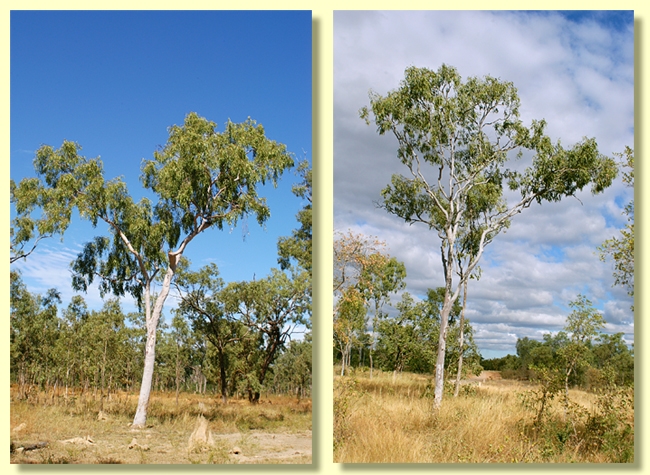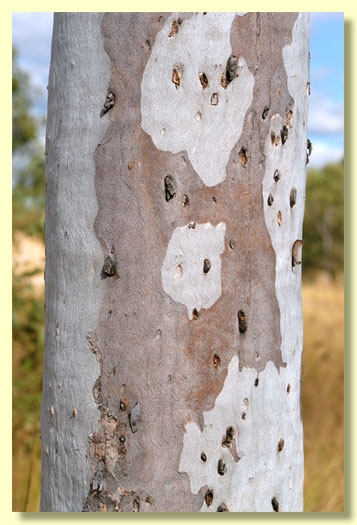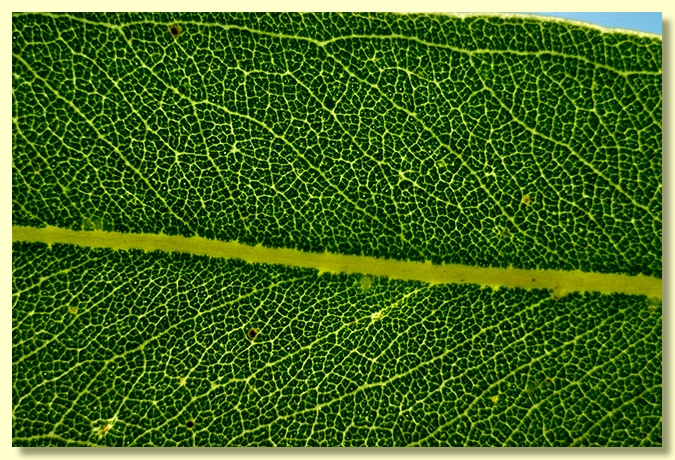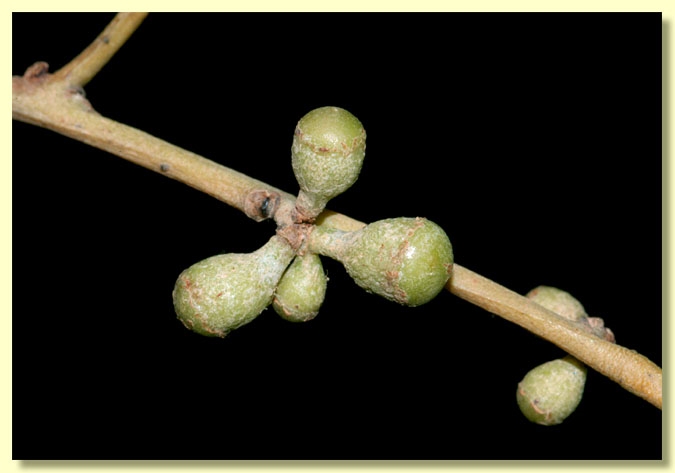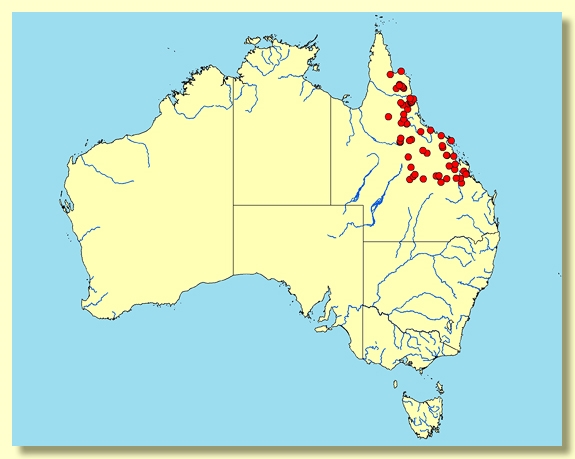Euclid - Online edition
Corymbia dallachiana
Corymbia | Blakearia
Corymbia dallachiana (Benth.) K.D.Hill & L.A.S.Johnson, Telopea 6: 451–2 (1995).
Eucalyptus tessellaris var. dallachiana Benth., Fl. Austral. 3: 251 (1867); Eucalyptus clavigera var. dallachiana (Benth.) Maiden, J. & Proc. Roy Soc. New South Wales 47: 77 (1913); Eucalyptus aparrerinja subsp. dallachiana (Benth.) M.I.H.Brooker & D.A.Kleinig (2004), Field Guide to Eucalypts. Volume 3, Northern Australia Edn. 2.: 56, 372. T: Queensland: Rockhampton, J.Dallachy 109; lecto: K; isolecto: MEL.
Tree to 15 m tall. Forming a lignotuber.
Bark smooth throughout, white to cream and pinkish grey, shedding in thin brown-grey patches, rarely with a very short stocking of rough ± tessellated grey bark at the base of the trunk.
Branchlets non-glaucous, smooth; ± elongated oil glands or ducts present in the pith.
Juvenile growth (coppice or field seedlings to 50 cm): stems rounded in cross-section, smooth; juvenile leaves always petiolate (petioles 1–2 cm), opposite for very few nodes then alternate, or alternate throughout, lower leaves elliptical then ovate to lanceolate, 10–26 cm long, 3.5–15 cm wide, base rounded to tapering or occasionally oblique for some leaves, apex rounded or pointed, leathery, often glossy, yellow-green to green, glabrous.
Crown of adult leaves alternate, petioles (0.9)1.2–3.8 cm long; blade lanceolate or falcate, 9.3–27 cm long, 0.9–3.4 cm wide, flat or slightly undulate, base tapering to petiole, margin entire or sometimes distantly scalloped, apex pointed, concolorous, glossy, slightly glossy or dull, green to yellow-green, side-veins at greater than 45° to midrib, reticulation dense to very dense, intramarginal vein present, oil glands not visible.
Inflorescence axillary compound, with rhachis internodes very shortened (condensed), usually with only a basal internode (0.2–0.5 cm long) and either no further internodes or a second internode to 0.2 cm long, rarely the earliest-formed of a new season's set of inflorescences may have 3 or 4 internodes, but subsequent inflorescences going up the branchlet conform to the usual condensed pattern, peduncles ± rounded, 0–0.3 cm long, buds usually in 3s on side-branches of inflorescence and in 7s terminally, pedicels 0.1–0.6 cm long. Mature buds pyriform, 0.5–0.7 cm long, 0.4–0.6 cm wide, smooth, often whitish but not waxy nor scurfy, scar present (outer operculum shed early), operculum rounded, stamens inflexed, all fertile, anthers oblong, dorsifixed, versatile, dehiscing by longitudinal slits, style long and straight, stigma ± blunt, locules 3, the placentae with ovule rows indistinct. Flowers white.
Fruit pedicellate (pedicels 0.1–0.6 cm long), cupular to ± cylindrical or barrel-shaped, 0.9–1.3 cm long, (0.6)0.7–1 cm wide, disc descending vertically or obliquely, valves 3, enclosed or at rim level.
Seeds brown, saucer-shaped, smooth, hilum ventral.
Cultivated seedlings (measured at ca node 10): not grown yet.
Flowering has been recorded in November and December.
Stately ghost gum tree endemic to Queensland where it is quite widespread east of a line from Coen to Jericho and south from Bathurst Bay to Rockhampton and Emerald, recorded also from Shaw Island in the Whitsunday Group. It is found on a wide range of sites usually of moderate fertility, as a component of grassy woodlands on plains and on creek levees, but has also been collected from granite ridges and dissected plateaus. Corymbia dallachiana is distinguished in its natural range by the combination of these features: striking, smooth, white, usually non-powdery trunk; crown of bright green, often glossy, long lanceolate alternate adult leaves; non-scabrid, petiolate, green, ovate to broadly lanceolate juvenile leaves; condensed axillary compound inflorescences and thin-walled typical ghost gum fruit.
Species of ghost gum most likely to be confused with C. dallachiana are the Desert ghost gum, C. aparrerinja, which has generally smaller adult leaves (though with some overlap in dimensions), and smaller, ovate, shortly petiolate juvenile leaves, usually bluish green. The geographic ranges of these two closely related species abut in the area around Barcaldine and intermediates can be found. C. tessellaris is distinguished from C. dallachiana by its characteristic well-developed stocking of grey clearly tessellated rough bark over part of the trunk, and the axillary inflorescences which are expanded so that several internodes are clearly visible. C. confertiflora has setose, broad crown leaves with very short petioles, strongly pedicellate buds and a tessellated stocking of rough bark. C. grandiflora has similar bark to C. dallachiana but larger, broader very glossy adult leaves and more robust buds and fruit with much longer pedicels. Smooth-barked ghost gum trees in the area south of Normanton have been variously referred to C. dallachiana, C. flavescens and C. grandifolia subsp. grandifolia and may be intermediate in character, and certainly require further investigation.
MORE ABOUT CORYMBIA
MORE ABOUT GHOST GUMS
Corymbia dallachiana: after John Dallachy (ca 1808–1871).
John Dallachy was born in Scotland and came to Australia in 1849 initially as Superintendent of Melbourne Botanic Gardens, but he spent much of his time collecting plants for Victorian government botanist Ferdinand von Mueller, especially in coastal Queensland.

